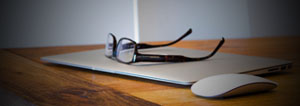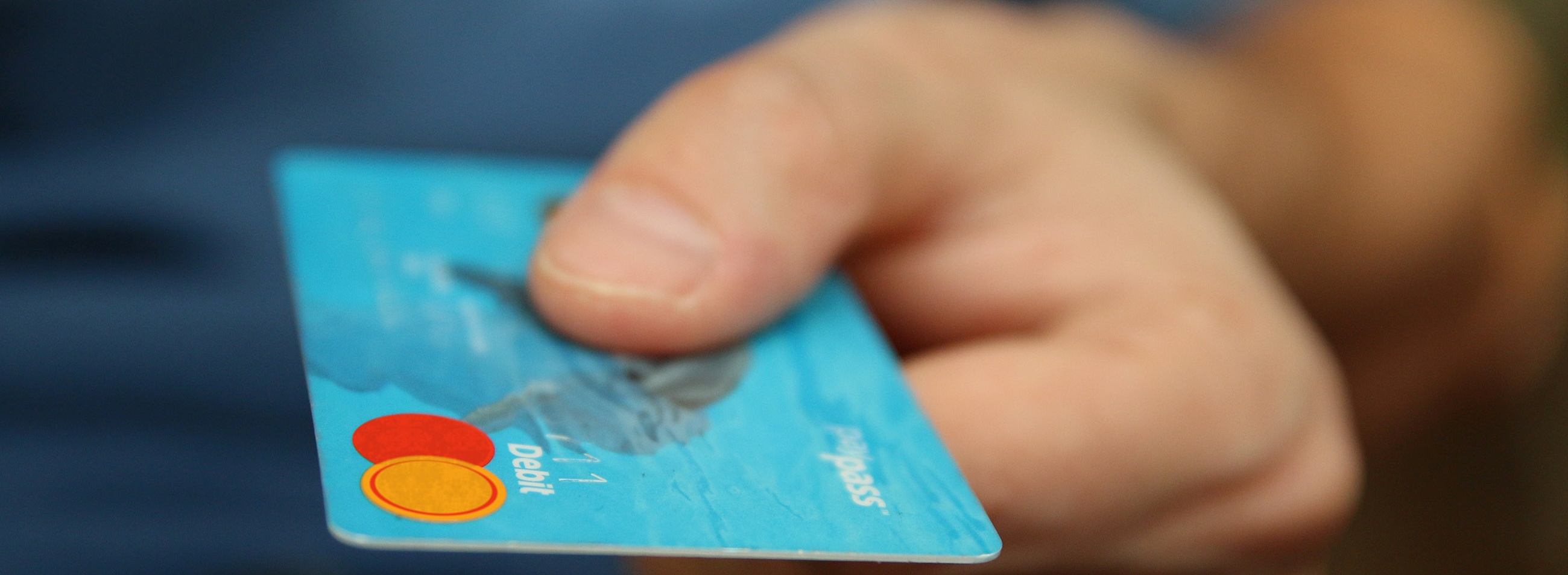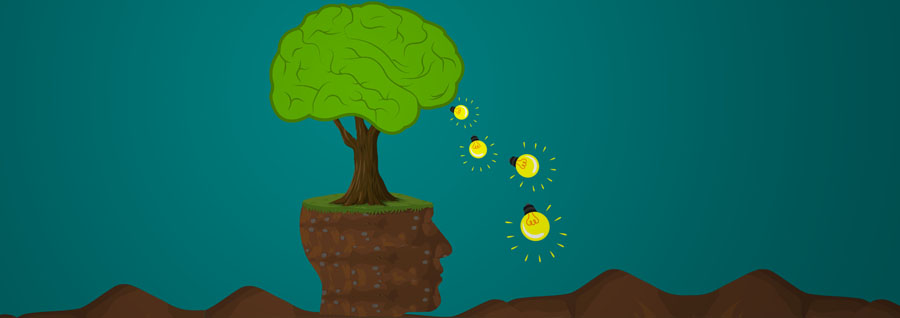Welcome to Fitness

Fitness is a state of health and well-being and, more specifically, the ability to perform aspects of sports, occupations and daily activities. Physical fitness is generally achieved through proper nutrition, moderate-vigorous physical exercise, and sufficient rest.
Fitness was defined as the capacity to carry out the day’s activities without undue fatigue. However, with automation and changes in lifestyles physical fitness is now considered a measure of the body's ability to function efficiently and effectively in work and leisure activities, to be healthy, to resist hypokinetic diseases, and to meet emergency situations.
Exercise is an essential part of staying healthy that, when done regularly, can make you stronger, improve your mood, and lengthen your life.[1] Whether you plan to exercise at home, outside, or in a gym, knowing the basics will make the whole process go more smoothly.
- Wear the right clothes. You will want to wear clothes that will not restrict your movements or blood flow. Don’t wear clothes which are too tight, especially around your joints. You will also want to wear clothing which is made of a material which breathes well, since you will sweat when doing many forms of exercise. Clothes specifically designed for exercise can easily be found.
- Wear the right shoes. Just because we call them tennis shoes does not mean they are great athletic shoes. Shoes like Converse have little shock absorbency and can be terrible for your feet and bones. Get shoes which fit comfortably and are designed for the type of activity that you intend to do.
- Hydrate. Drink lots of water before you exercise. Your body will need the water to help your muscles work and also to help you sweat. If you’re dehydrated before you start, just think about how you’ll feel afterwards!
- Do warm up exercises. Though researchers cannot agree definitively on whether or not warm ups help you to perform better in exercises, they all agree that warming up certainly won’t hurt.[2] Warm up before exercising by doing a less intense version of your intended workout for 5-10 minutes. If you plan to run, jog first. If you intend to swim, swim slowly.
-
Check with your doctor. Certain conditions may make it a good idea to check with your doctor before starting an exercise regimen. There are exercises for every health condition[3], but it’s a good idea to know what to avoid. Exercising should make you feel healthy and good in your own body: not hurt you!
If you have diseases or conditions like asthma or lung problems, arthritis, diabetes or liver and kidney problems, or heart disease, definitely talk to your doctor before starting a new exercise regimen.
If you notice certain problems, you will also want to talk to a doctor. These include things like pain or dizziness following physical exertion, shortness of breath after very mild exertion or when at rest, or swelling in the ankles.
You may also want to talk to a doctor simply to find out what kind of exercise they recommend for your particular goals and health conditions. You can also consult with a nutritionist and a trainer for more information on exercising and how you can best meet your goals.
- Understand aerobic exercise. Aerobic exercise is often called a “cardio” workout, since it is designed to increase and improve blood flow. These types of exercises are of a lower intensity but last for longer periods of time.
- Climb stairs. Climbing stairs is a great way to get your heart rate up. You can climb actual stairs or you can use a stair machine at a gym. Climbing stairs improves your leg muscles as well as your butt. Be careful if using actual stairs, however, as you do not want to fall and get seriously injured.
- Jump rope. This is not just a fun game for children but also an excellent workout. Working the arms, legs and core muscles, this is an exercise that you can easily do at home. It is also well known for improving balance and is excellent for people who intend to play sports.
- Do jumping jacks. Jumping jacks are an exercise performed by standing with the legs together, arms at your side, and then jumping to move the legs outward and raising the arm together above your head. Jump again to return to the starting position. These are great for getting your heart rate up and burning calories.
- Walk or jog. Walking and jogging are wonderful ways to get your heart rate up. Though jogging may be difficult on the knees for some people, walking is certainly an accessible exercise and should be done by those at every level. Studies have shown that walking an hour a day can help you maintain your weight over time and reduce your likelihood of certain conditions, like hypertension and obesity.
- Swim. Swimming is great exercise and is fun to boot. This will work different muscles depending on the style of swimming you do. Swimming is frequently recommended for people with joint problems or those that are significantly overweight, as it can take a great deal of strain off of the skeleton while still raising the heart rate.
- Bike. Riding your bike is an accessible, environmentally friendly, and very effective way to get exercise. Working muscles in most areas of the body, bike riding will get your heart rate up while it gets you somewhere! You can bike outside or you can get a stationary bike and stay at home.
- Understand anaerobic exercise. Anaerobic exercises are those done at a higher intensity for shorter periods of time. These build strength and help your body to become accommodated to working hard. Paired with a healthy diet, these exercises can also help you to lose weight, as your body’s caloric use will increase. These types of exercise are actually arguably better for burning fat than aerobic exercises.
- Run. Running is tough on the knees and bone structure but is still an excellent form of exercise. You can run locally around your neighborhood or around a track at a gym. Remember that running is different than jogging: it’s much faster and much harder to do!
- Lift weights. There are many different types of weights you can lift and ways to lift them, but doing this type of exercise will help you build a variety of muscles and increase your strength. Be sure to start small and work your way up, since trying to lift something which is too heavy is a common way to injure yourself.
- Do push-ups. Push ups are done by placing yourself with your stomach on the ground. Place your feet so that your toes are flat on the ground, then place your hands flat on the ground at face level, a shoulder’s width apart. Then, keeping the line of your back and legs completely straight, lift your body with your arms by pushing against the ground so that your whole body is supported on your toes and hands. Lower yourself back down so that your nose is nearly touching the ground and then raise yourself back up. Repeat.
- Try squats. Squats are done by standing with your feet a shoulder’s width apart, back straight, arms crossed in front of you, and slowly lowering yourself down as if to sit in a chair. Once in the sitting position, slowly raise yourself back up. These are a great exercise for your core and leg muscles.
- Do burpees. Burpees (a common military exercise) are done starting in a standing position, then drop to a crouch, jump the legs back into push-up position, do one push-up (if you want), hop your legs back to the crouch position, and then jump straight upwards with hands raised to return to the standing position. This is a great workout as it exercises all areas of the body.
- Understand core exercises. Core workouts develop the muscles around your abdomen. This has many benefits. With a stronger core, you will be less prone to back pain and injury and you will also be able to improve bad posture. Paired with weight loss, strong core muscles will also give you defined abs.
- Try planks. Planks are probably the most efficient core exercise. You can greatly improve your core strength with just a few minutes of this exercise every day. Planks are done by taking a position similar to a push up, but supporting the upper half of your body on your forearms and holding the position for as long as possible. It will surprise you how difficult it is if you’ve never tried it but the exercise is extremely effective.
- Do crunches . Crunches are another great core exercise, done by lying face up, knees bent, arms crossed at your chest, and lifting just the head and shoulder up towards the pelvis. Lower yourself back down and repeat.
- Do sit-ups. Sit ups are similar to crunches and are done by lying face up, knees bent only slightly, and rolling your upper body into a sitting position. You can cross your arms in front of you or run your palms up and down your thighs as you move to guide your movement.
- Try bridges. Bridges are a great core exercise because they also work on your bottom and lower back muscles. These are done by lying on your back, with your knees bent and your arms flat on the ground at your sides. Slowly roll your back and lift your hips until a straight line is created between your shoulders and knees, your back and thighs parallel, and then slowly lower it back into starting position.
- Try T’ai chi. T’ai chi is a Chinese martial art, the forms of which are done in sequences of slow movements. Doing t’ai chi will allow you to build better balance but it can also be very relaxing. Find a local group to practice with or take a class from a local gym or community center. You can also find lessons online or DVDs which will allow you to practice at home.
- Do weight shifts. Weight shifts are a great starting balancing exercise. These are done by standing with both feet on the ground, hip width apart. Next, shift all of your weight onto one leg and lift the other slightly off of the floor. Hold the position, trying to maintain good form, for 30 seconds. Do the other leg. Repeat as much as you want.
- Try to single-leg balance. These are done same as the above, with the exception that the lifted leg is bent backwards at the knee. This will work on your front-to-back balance, whereas the previous one focuses more on side-to-side. Both should be used in conjunction.
- Try Pilates. Pilates is a series of forms and movements which occasionally makes use of tools like exercise balls, weights, and resistance bands. This form of exercise helps train muscles with the correct movement patterns which can improve balance, core strength, posture and flexibility. Find a local group to practice with or take a class from a local gym or community center. You can also find lessons online or DVDs which will allow you to practice at home.
- Try Yoga. Yoga is an Indian meditation technique and exercise which has been shown to reduce stress and anxiety (in turn aiding weight loss) and is excellent for building better balance and flexibility. Find a local group to practice with or take a class from a local gym or community center. You can also find lessons online or DVDs which will allow you to practice at home.
- Try dance. Various forms of dance, such as ballet, are actually fairly rigorous exercise and can significantly improve your flexibility, as well as your coordination. Find a local group to practice with or take a class from a local gym or community center.
-
Do stretches. Stretches should be done after warming up or exercising, as this will help prevent muscle strain and injury. Stretching your muscles will help provide much greater flexibility and can reduce the likelihood of injury due to strain during other exercises later on.
A basic stretch to try is a hamstring stretch. This is done by sitting, splaying your legs apart, and reaching forward to touch one foot at a time. You can bend the leg which is not being reached across.
Another basic stretch is a butterfly groin stretch. This is done by sitting on the floor and pulling both ankles in towards your crotch, getting as close as you can. Try to press your knees to the floor as you do this.
Try a simple shoulder stretch. This is done by pulling your elbow across the front of your body towards the opposite shoulder. Press against your arm as you do this.
This wall stretch aids mobility in the chest, shoulders, abs, hip flexors, quads and calves. Face a wall standing about a foot away from it, then reach your hands up as high as you can flat against the wall, leaning forward into it with your chest and hips while keeping your feet in position flat on the floor.
- Fit exercise in whenever you can. You don’t have to dedicate hours of your day to exercising. Anything helps, so find ways to fit exercise into the smaller “in between” moments of your day. You can do squats while you wait for food to cook or microwave or fit in a minute of planks when you first wake up. Look and you will find moments in your day to get a little more active.
- Skip the chair. If you spend most of your day sitting in a desk chair, you will find you have a lot to gain from finding an alternative. Using a standing desk or a standing desk in combination with a treadmill will get you burning calories while you work (it doesn’t even have to be fast paced, though the harder it is the more you’ll get out of it). If that’s not for you, try an exercise ball instead of a desk chair. Some research has found that using these methods can help you lose over 40 lbs a year if you’re overweight.
- Stop using elevators. When getting to your apartment or office, skip the elevator and take the stairs instead. This is great because you can add a floor at a time as it becomes easier for you to get up the stairs. Eventually you can also run up the stairs for some added exercise.
- Get out of the car. Whenever you can, stop using your car if it is possible for you to get yourself where you’re going on foot or on a bike. Turn grocery shopping into a workout by walking to the store a few times a week to pick up a smaller number of items. Take a bus to work and get off a few stops early to walk. Ride your bike to work if you can. If you have to take your car, park really far away from your building. This is a great way to introduce physical activity into your day.
- Walk or jog for 30 minutes. This can be broken up into three 10 minute sets.
- Do 30 bridges. If you can, do these in one set. However, they can be broken up into 2-3 sets.
- Do planks for 1 minute. This will obviously need to be broken up. Simply keep the position for as long as you can, rest for a few seconds, and then return.
- Do 30 push-ups. If you can, do these in one set. However, they can be broken up into 2-3 sets.
- Do 30 seated squats. Sit in a chair, stand up and repeat. You can try doing these squats without the chair if you have the strength and balance to do so.
- Walk or jog for 1 hour. This can be broken up into two half-hour sets.
- Do 50 crunches. If you can, do these in one set. However, they can be broken up into 2-3 sets.
- Do planks for 2 minutes. This will obviously need to be broken up. Simply keep the position for as long as you can, rest for 30 seconds, and then return.
- Do 25-50 burpees. If you can, do these in one set. However, they can be broken up into 2-3 sets.
- Climb stairs for 15 minutes. This can be broken up into three 5 minute sets.
- Jog or run for 1 hour. This can be broken up into two half-hour sets.
- Do 100 sit-ups. If you can, do these in one set. However, they can be broken up into 2-3 sets.
- Do planks for 2-3 minutes. At this point you need to work in variations like the side plank and reverse plank as well. Simply keep the position for as long as you can, rest for a minute, and then return.
- Lift weights for 30-45 minutes . You will want to choose weights and positions based on the muscle groups you wish to focus on. Break up the hour into three 20 minute sets and try to work different muscle groups in each set.
- Jump rope for 30 minutes. This can be broken up into three 10 minute sets.
- Understand interval training. Interval training is any exercise done at a very high intensity for only a few brief minutes (2-3 at most) and alternated with either no activity or a slow paced activity. Interval training is widely regarded to be one of the most effective exercise regimens, since it is less time consuming but appears to produce identical effects.
-
Do a sprint-walk routine. The most basic interval training routine would be to sprint for 2-3 blocks (or the equivalent of 400 meters) and then walk back to the starting point, beginning the process over again.
An alternative would be to combine this with an aerobic workout. Warm up by walking slowly for five minutes, quickly for ten minutes, sprint for three blocks, walk back two block, sprint for three blocks, walk back two blocks (and so on, lasting 15 minutes), and then walking back quickly to your origin point to cool down. - Apply to your preferred activity. You can apply interval training to almost any exercise activity. Try cycling, swimming, many core exercises, and so on. Try to alternate between exercise activities on different days to ensure that all of your muscle groups get attention.
- Devote time to exercising. You will want to set your goal for exercising at least ½ an hour a day. Slowly, over time, you should draw this out to 1 hour. This time period, however, can be broken up into sections and spread over the course of the day, however, those sections should be no less than 10 minutes. When you begin, exercise at least 2 days a week. Over time you should increase your frequency up to 5 days a week.
-
Walk. Walking is the best thing you can do for improving your health. As discussed above, a study found that a mixture of intense and relaxed walking in senior citizens decreased the likelihood of certain diseases by 20%. [13] You can walk with your friends, family members, or by yourself. If you want to walk in the comfort of indoors, you can walk around the inside of your apartment building or you can walk the inner corridor of the local mall. You can also walk outside if you prefer.
Try to walk for at least half an hour a day and go at a pace that gets your heart rate up. If you do not push your body at least a little, you will not gain nearly as much from the exercise. -
Do balance exercises. As we age, we tend to lose a lot of our balance. This is normal. However, you will want to work on your balance to help ensure that you can move around without hurting yourself. Do balance exercises to protect yourself and prevent injury.
A good, basic balance exercise is to try standing on one leg. Make sure to do both legs in turn and to also have a chair nearby to hold on to if necessary to prevent falling. - Do flexibility exercises. Muscles lose their elasticity over time, which can make it difficult for you to move around or get up if you fall. Do flexibility exercises like stretches to maintain your muscles and keep you safe and independent.
- Do strength exercises. Lift small, 2lb weights (more if you can). This will help you maintain the strength in your hands and arms, allowing you greater independence for longer.
- Do cool down exercises. Cool down exercises, like warm up exercises, are a gentler exercise, meant to ease your body between working hard and being at rest. Cool down by walking for 5-10 minutes and (preferably) stretching. Stretching before exercising is likely to cause injury but stretching after exercise, when the muscles are warm and active, will help improve their tone and flexibility.
- Get electrolytes and drink water. When you exercise, your muscles use up and your body sweats out a number of essential nutrients. You need to replace these nutrients or you can hurt yourself or become sick. These nutrients, water, sodium, potassium, and sugar, can be consumed in a number of ways. You could try drinking water and eating a banana or drinking water and eating a protein bar, among a variety of other options. If you choose to drink a sports drink, it is best to dilute the drink at a ration of 6 to 1 (that is 6 parts water for each part drink) since these drink's sugar content is unnecessarily high.
-
Manage the pain. Exercising, especially the kind that pushes your body beyond its comfort level (the good kind!), can cause muscle pain and discomfort. This is normal and a healthy sign of your body getting into shape and becoming stronger. You may want to manage the pain though. This can be done by taking acetaminophen or ibuprofen or using an ice pack.
Intense pain with a fast onset is an indication that you have injured yourself. Consult with a doctor or nurse, especially if it is very severe or lasts for more than a few days.
Prevent muscle pain to begin with by slowly easing into exercise, both in an individual routine but also over the course of time. Don’t leap straight into a high intensity program but rather build yourself up to that level over the course of several months.
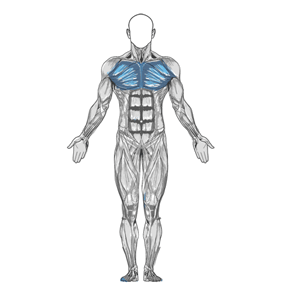 Lie down on a flat bench with a dumbbell in each hand resting on top of your thighs. The palms of your hands will be facing each other.
Lie down on a flat bench with a dumbbell in each hand resting on top of your thighs. The palms of your hands will be facing each other.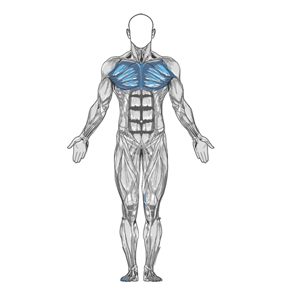 Sit on the machine with your back flat on the pad.
Sit on the machine with your back flat on the pad.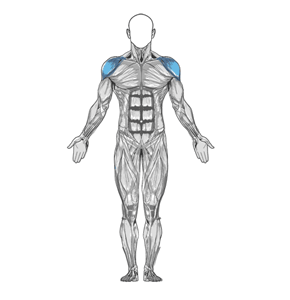 Start by placing a barbell that is about chest high on a squat rack. Once you have selected the weights, grab the barbell using a pronated (palms facing forward) grip. Make sure to grip the bar wider than shoulder width apart from each other.
Start by placing a barbell that is about chest high on a squat rack. Once you have selected the weights, grab the barbell using a pronated (palms facing forward) grip. Make sure to grip the bar wider than shoulder width apart from each other. Attach a straight or angled bar to a high pulley and grab with an overhand grip (palms facing down) at shoulder width.
Attach a straight or angled bar to a high pulley and grab with an overhand grip (palms facing down) at shoulder width.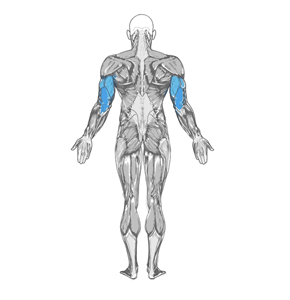 Lie on a flat bench with either an e-z bar (my preference) or a straight bar placed on the floor behind your head and your feet on the floor.
Lie on a flat bench with either an e-z bar (my preference) or a straight bar placed on the floor behind your head and your feet on the floor.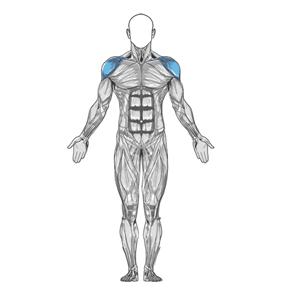 Pick a couple of dumbbells and stand with a straight torso and the dumbbells by your side at arms length with the palms of the hand facing you. This will be your starting position.
Pick a couple of dumbbells and stand with a straight torso and the dumbbells by your side at arms length with the palms of the hand facing you. This will be your starting position.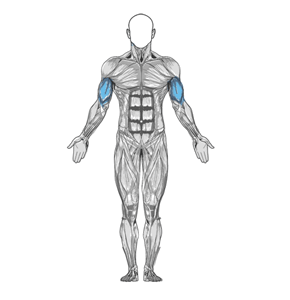 To perform this movement you will need a preacher bench and an E-Z bar. Grab the E-Z curl bar at the close inner handle (either have someone hand you the bar which is preferable or grab the bar from the front bar rest provided by most preacher benches). The palm of your hands should be facing forward and they should be slightly tilted inwards due to the shape of the bar.
To perform this movement you will need a preacher bench and an E-Z bar. Grab the E-Z curl bar at the close inner handle (either have someone hand you the bar which is preferable or grab the bar from the front bar rest provided by most preacher benches). The palm of your hands should be facing forward and they should be slightly tilted inwards due to the shape of the bar.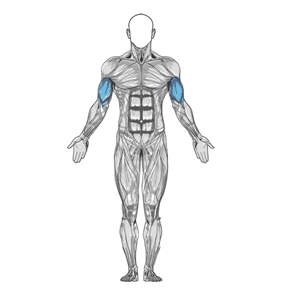 Sit on a flat bench with a dumbbell on each hand being held at arms length. The elbows should be close to the torso.
Sit on a flat bench with a dumbbell on each hand being held at arms length. The elbows should be close to the torso.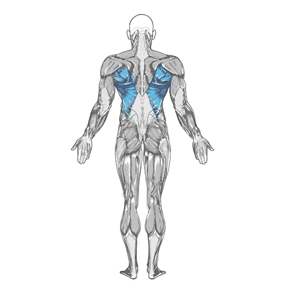 Sit down on a pull-down machine with a wide bar attached to the top pulley. Make sure that you adjust the knee pad of the machine to fit your height. These pads will prevent your body from being raised by the resistance attached to the bar.
Sit down on a pull-down machine with a wide bar attached to the top pulley. Make sure that you adjust the knee pad of the machine to fit your height. These pads will prevent your body from being raised by the resistance attached to the bar.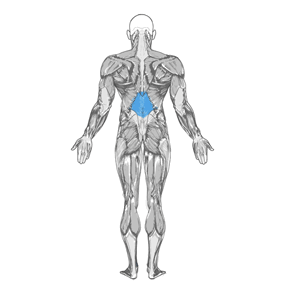 Choose a flat bench and place a dumbbell on each side of it.
Choose a flat bench and place a dumbbell on each side of it.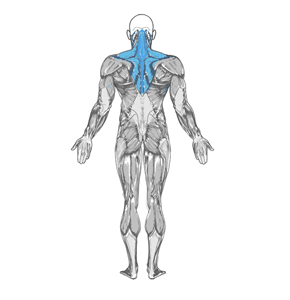 Stand erect with a dumbbell on each hand (palms facing your torso), arms extended on the sides.
Stand erect with a dumbbell on each hand (palms facing your torso), arms extended on the sides.
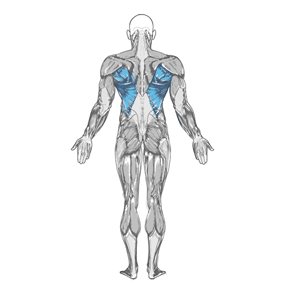 Grab the pull-up bar with the palms facing your torso and a grip closer than the shoulder width.
Grab the pull-up bar with the palms facing your torso and a grip closer than the shoulder width.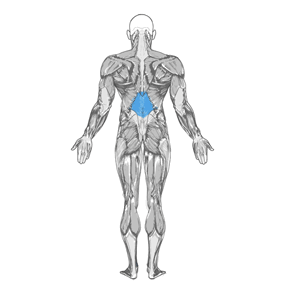 For this exercise you will need access to a low pulley row machine with a V-bar. Note: The V-bar will enable you to have a neutral grip where the palms of your hands face each other. To get into the starting position, first sit down on the machine and place your feet on the front platform or crossbar provided making sure that your knees are slightly bent and not locked.
For this exercise you will need access to a low pulley row machine with a V-bar. Note: The V-bar will enable you to have a neutral grip where the palms of your hands face each other. To get into the starting position, first sit down on the machine and place your feet on the front platform or crossbar provided making sure that your knees are slightly bent and not locked.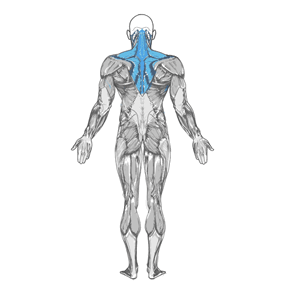 Grasp a straight bar cable attachment that is attached to a low pulley with a pronated (palms facing your thighs) grip that is slightly less than shoulder width. The bar should be resting on top of your thighs. Your arms should be extended with a slight bend at the elbows and your back should be straight. This will be your starting position.
Grasp a straight bar cable attachment that is attached to a low pulley with a pronated (palms facing your thighs) grip that is slightly less than shoulder width. The bar should be resting on top of your thighs. Your arms should be extended with a slight bend at the elbows and your back should be straight. This will be your starting position.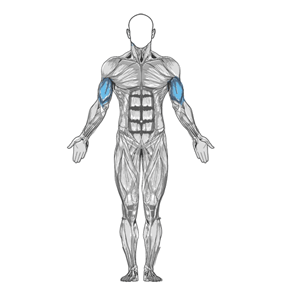 Stand up straight while holding an EZ curl bar at the wide outer handle. The palms of your hands should be facing forward and slightly tilted inward due to the shape of the bar. Keep your elbows close to your torso. This will be your starting position.
Stand up straight while holding an EZ curl bar at the wide outer handle. The palms of your hands should be facing forward and slightly tilted inward due to the shape of the bar. Keep your elbows close to your torso. This will be your starting position.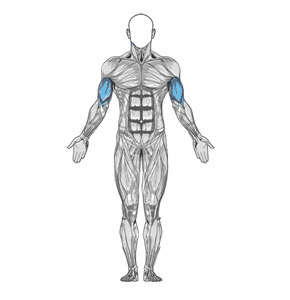 Stand up with your torso upright and a dumbbell on each hand being held at arms length. The elbows should be close to the torso.
Stand up with your torso upright and a dumbbell on each hand being held at arms length. The elbows should be close to the torso.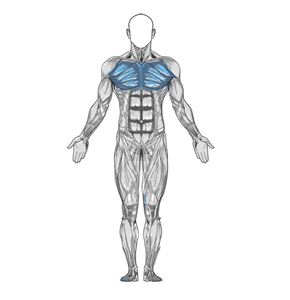 Lie back on an incline bench with a dumbbell in each hand atop your thighs. The palms of your hands will be facing each other.
Lie back on an incline bench with a dumbbell in each hand atop your thighs. The palms of your hands will be facing each other.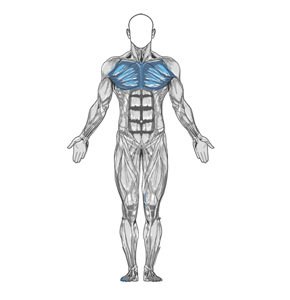 To get yourself into the starting position, place the pulleys on a high position (above your head), select the resistance to be used and hold the pulleys in each hand.
To get yourself into the starting position, place the pulleys on a high position (above your head), select the resistance to be used and hold the pulleys in each hand.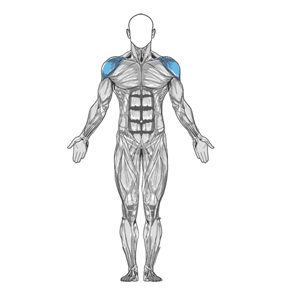 Start by placing a barbell that is about chest high on a squat rack. Once you have selected the weights, grab the barbell using a pronated (palms facing forward) grip. Make sure to grip the bar wider than shoulder width apart from each other.
Start by placing a barbell that is about chest high on a squat rack. Once you have selected the weights, grab the barbell using a pronated (palms facing forward) grip. Make sure to grip the bar wider than shoulder width apart from each other.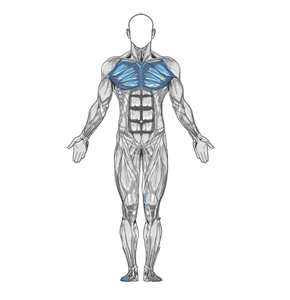 For this exercise you will need access to parallel bars. To get yourself into the starting position, hold your body at arms length (arms locked) above the bars.
For this exercise you will need access to parallel bars. To get yourself into the starting position, hold your body at arms length (arms locked) above the bars.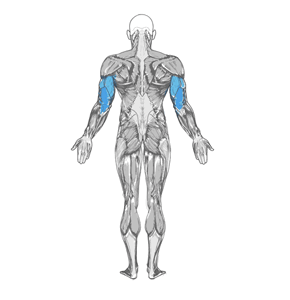 Attach a rope attachment to a high pulley and grab with a neutral grip (palms facing each other).
Attach a rope attachment to a high pulley and grab with a neutral grip (palms facing each other).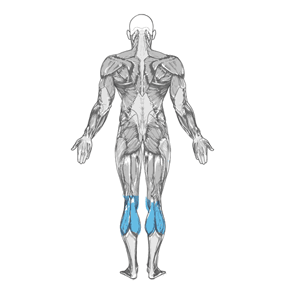 For this exercise you will need access to a donkey calf raise machine. Start by positioning your lower back and hips under the padded lever provided. The tailbone area should be the one making contact with the pad.
For this exercise you will need access to a donkey calf raise machine. Start by positioning your lower back and hips under the padded lever provided. The tailbone area should be the one making contact with the pad.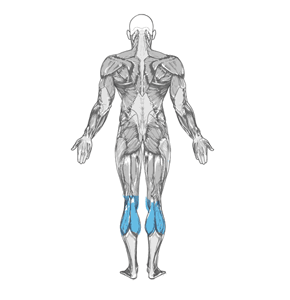 Adjust the padded lever of the calf raise machine to fit your height.
Adjust the padded lever of the calf raise machine to fit your height.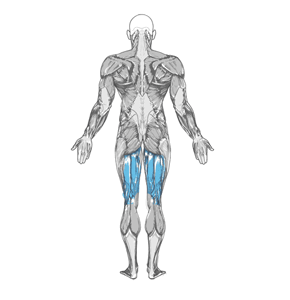 Adjust the machine lever to fit your height and sit on the machine with your back against the back support pad.
Adjust the machine lever to fit your height and sit on the machine with your back against the back support pad.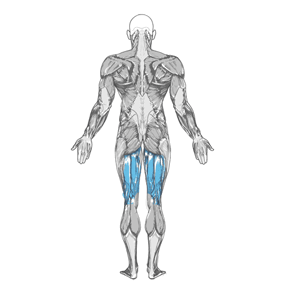 Adjust the machine lever to fit your height and lie with your torso bent at the waist facing forward around 30-45 degrees (since an angled position is more favorable for hamstrings recruitment) with the pad of the lever on the back of your right leg (just a few inches under the calves) and the front of the right leg on top of the machine pad.
Adjust the machine lever to fit your height and lie with your torso bent at the waist facing forward around 30-45 degrees (since an angled position is more favorable for hamstrings recruitment) with the pad of the lever on the back of your right leg (just a few inches under the calves) and the front of the right leg on top of the machine pad.
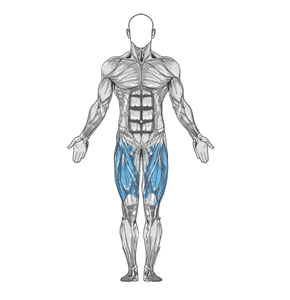 Using a leg press machine, sit down on the machine and place your legs on the platform directly in front of you at a medium (shoulder width) foot stance. (Note: For the purposes of this discussion we will use the medium stance described above which targets overall development; however you can choose any of the three stances described in the foot positioning section).
Using a leg press machine, sit down on the machine and place your legs on the platform directly in front of you at a medium (shoulder width) foot stance. (Note: For the purposes of this discussion we will use the medium stance described above which targets overall development; however you can choose any of the three stances described in the foot positioning section).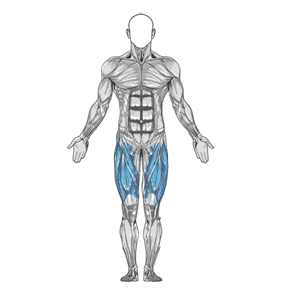 Place the back of your torso against the back pad of the machine and hook your shoulders under the shoulder pads provided.
Place the back of your torso against the back pad of the machine and hook your shoulders under the shoulder pads provided.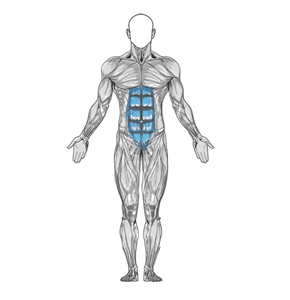 Select a light resistance and sit down on the ab machine placing your feet under the pads provided and grabbing the top handles. Your arms should be bent at a 90 degree angle as you rest the triceps on the pads provided. This will be your starting position.
Select a light resistance and sit down on the ab machine placing your feet under the pads provided and grabbing the top handles. Your arms should be bent at a 90 degree angle as you rest the triceps on the pads provided. This will be your starting position.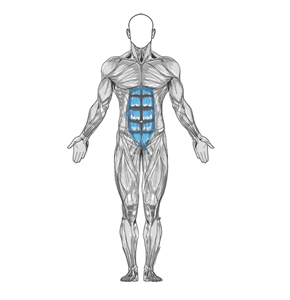 Lie flat on your back with your feet flat on the ground, or resting on a bench with your knees bent at a 90 degree angle. If you are resting your feet on a bench, place them three to four inches apart and point your toes inward so they touch.
Lie flat on your back with your feet flat on the ground, or resting on a bench with your knees bent at a 90 degree angle. If you are resting your feet on a bench, place them three to four inches apart and point your toes inward so they touch.